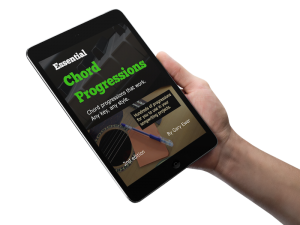Every chord has contains at least 3 notes: C uses C-E-G; Dm uses D-F-A; Em uses E-G-B, and so on. Some chords contain more than 3. For example, G7 has the 3 notes that make up the “triad” part: G-B-D, and then a 7th on top, making it a 4-note chord: G-B-D-F.
The root of a chord is the note represented by its letter name. So in a C chord, the note C is the root. Most of the time when you play a chord in a song, you’re playing the root at the bottom of that chord. Those are called root-position chords, and they account for probably at least 90% of the chords you play.
 “The Essential Secrets of Songwriting” eBook bundle comes with a free copy of “Creative Chord Progressions”. Learn how to take your chords beyond simple I-IV-V progressions. With pages of examples ready for you to use in your own songs!
“The Essential Secrets of Songwriting” eBook bundle comes with a free copy of “Creative Chord Progressions”. Learn how to take your chords beyond simple I-IV-V progressions. With pages of examples ready for you to use in your own songs!
But once in a while, it’s nice to use a chord inversion. To invert a chord means to place a note other than the root at the bottom. When we do that, we show the bass note after a slash. For example, C/E means to play a C chord, but put the note E in the bass. Using that slash between the chord and the bass note is why they’re called slash chords.
The Difference Between Root Position Chords and Inversions
You’ll notice that there’s not a great difference in sound between a root position chord and an inversion of the same chord. C and C/E sound roughly the same. The only difference is a musical one: an inverted chord is said to be a bit less stable than a root position one.
C
C/E
And if you place the 5th of the chord in the bass (C/G) you’ll notice that the chord sounds even less stable, musically:
C/G
This whole idea of a chord sounding “less stable” is hard to pick out, and I certainly don’t want to make you think that “less stable” means undesirable somehow. It’s not a negative quality. Every chord, whether it’s a very stable root position chord, or a less stable one with the 5th in the bass, has a use in music.
Why We Usually Use Slash Chords
So what is the use of a chord inversion? Why do we opt to use them at all?
There are 2 main reasons to use a slash chord: 1) To provide a nice variety of sound to a constantly-played chord; and 2) to smooth out a bass line.
Let’s look at an example that gives us both benefits: Let’s say that you’ve got this: C F G C, where the first C is played for 4 beats, and then is followed by the other chords which are played for two beats each:
That first bar might sound a bit boring, holding on to that C chord for so long. You can improve that by playing C for 2 beats, and then switching to C/E for the next 2 beats. It provides a nice variety of sound without making a radical change to the progression:
So by using C/E, you create a nice change in the progression, but you also smooth out the bass line. That’s not to say that jumpy bass lines aren’t nice. But you may be looking for a way to have your bass move more evenly through a progression, and if you are, an inversion can do that for you.
Slash Chords to Experiment With
The best way to get a handle on chord inversions is to experiment with them. Try the following chord progression pairs, each of which are separated by a double line. The first of each pair is a simple progression with no inversions used. The second of each pair uses an inversion to either smooth out the bass, or to create a variety in the sound, or both.
Remember to make the note after a slash your lowest-sounding note (i.e., the bass note) :
- C G F G C ||C G/B F/A G C
- C Bb Eb F C ||C Bb/D Eb F C
- Am_____ F G Am ||Am Am/G F G Am
- Am Em Dm G Am ||Am Em Dm/F G Am
- C F C G C ||C F C/G G C
- C G C F C G C ||C G/D C/E F C/G G C
 Written by Gary Ewer. Follow Gary on Twitter.
Written by Gary Ewer. Follow Gary on Twitter.
 Looking for lists of progressions you can use in your own songs? “The Essential Secrets of Songwriting” eBook Bundle has 2 main collections, plus eBooks on how to harmonize your own melodies, and more.
Looking for lists of progressions you can use in your own songs? “The Essential Secrets of Songwriting” eBook Bundle has 2 main collections, plus eBooks on how to harmonize your own melodies, and more.











Pingback: How to Use Chord Inversions (“Slash Chords”) – Plus 6 Examples - The Hit Songwriting Formula | The Hit Songwriting Formula